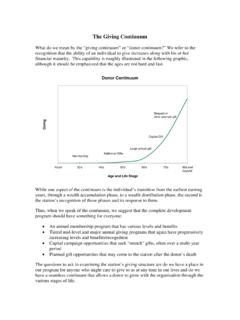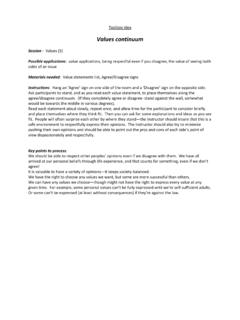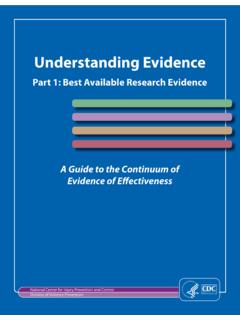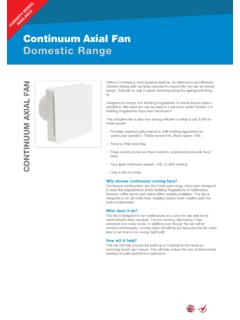Transcription of continuum of care - WHO
1 Opportunities for Africa s Newborns 23 IIMothers, newborns, and children are inseparably linked in life and in health care needs. In the past,maternal and child health policy and programmes tended to address the mother and child separately,resulting in gaps in care which especially affect newborn babies. How can these gaps be addressed,especially during birth and the first days of life, when most mothers and newborns die, and at home,where most newborn deaths in Africa occur? Policy and programme attention is shifting towards a maternal, newborn, and child health (MNCH) continuum of care . Instead of competing calls for mother or child, the focus is on universal coverage ofeffective interventions, integrating care throughout the lifecycle and building a comprehensive andresponsive health system. The MNCH continuum of care can be achieved through a combination of welldefined polices and strategies to improve home care practices and health care services throughout thelifecycle, building on existing programmes and packages.
2 What is the current coverage of MNCH essential packages along the continuum of care , and how can these be strengthened to increasecoverage, equity, and quality of care ? Which interventions within the continuum of care would savenewborn lives? Are there specific opportunities that could be seized?The maternal, newborn, and child healthcontinuum of careJoseph de Graft-Johnson, Kate Kerber, Anne Tinker, Susan Otchere, Indira Narayanan, Rumishael Shoo, Doyin Oluwole, Joy Lawn24 Opportunities for Africa s NewbornsThe continuum of care reachingmothers and babies at the crucial time and placeIn Africa, most maternal and newborn deaths occurduring childbirth and in the first few days of life, andmany of these deaths happen at home, particularly for million African newborns dying each introduces the continuum of care , which hasbeen identified as a core principle and framework tounderpin strategies to save the lives of mothers and babiesand promote overall continuum of care hastwo dimensions.
3 Firstly the timeof care giving, andsecondly the placeand approach of care gap in care around the timeof birth, when therisks are highest for mother and baby. During birthand the first few days of life, over half of all maternal3andnewborn1deaths occur in addition to intrapartumstillbirths. Although more mothers and newborns dieduring this time period than at any other time, coverageof care is at its lowest, and quality of care may also be low. An effective continuum of care connects essentialmaternal, newborn, and child health (MNCH)packages, throughout adolescence, pregnancy,childbirth, postnatal and newborn periods and intochildhood, building upon their natural interactionsthroughout the lifecycle (Figure ). For example,better conditions for adolescent girls, including access tofamily planning services, can contribute to a wantedpregnancy at the right time; good care during pregnancyincreases the chances of a safe birth; and skilled care atand immediately after birth reduces the risk of death ordisability for both the mother and the baby.
4 The effectin each time period depends on the foundation set inthe preceding time period, ensuring a morecomprehensive health care experience for each womanand the public health level, linking thesepackages and integrating service delivery results in morelives saved at less cost a more integrated and efficienthealth along the continuum alsopromotes opportunities to link with other importantprogrammes along the continuum of care , such asnutrition promotion, in addition to more vertical programmes, such as prevention of mother-to-childtransmission (PMTCT) of HIV, malaria control, andimmunisation programmes. The gap in care at the placewhere it is most most African countries, maternal, newborn, and childdeaths occur at home, often because they are affected bydelays in reaching the care they need. Babies are especiallyvulnerable to these delays in receiving care a baby withbirth asphyxia, sepsis, or complications of preterm birthcan die within hours or even minutes if appropriate careis not provided.
5 Opportunities for strengthening care inthe household may be missed because families are notinformed or not empowered to act on healthy choices, orthe socioeconomic conditions in which they live impedehealthy choices. Long distances, delays in accessing care ,financial considerations and, at times, poor quality care inthe health facility all contribute to poor MNCH outcomes. Poor communication and weak referral linksbetween community and facility can further limit the careprovided to those who need it most. An effective continuum of care strengthens the linksbetween the home and the first level facility and thehospital, assuring the appropriate care is available in eachplace (Figure ). This is the second dimension of acontinuum of care . Strategies involve improving the skillsof health workers, strengthening health system supports,and improving household and community practices andcommunity actions for health.
6 This approach also bringscare closer to the home through outreach services andpromotes referral by strengthening access to andimproving the quality of services at peripheral and districtlevel effective care in healthfacilities, healthy behaviours at home and early careseeking for illness will have the biggest impact on mother,newborn and child health. FIGURE care throughout the crucial time periods in the lifecycle Source: Adapted from references5;6s28yearsNeonatalperiodPregn ancyInfancyAdolescenceReproductive yearsPre-school yearsSchool-age28 daysBirth5years10 years20 yearsAgeingDeath1yearAdulthoodChildhoodP ostnatal(mother)BirthPregnancyAdolescenc e and pre- pregnancyLinking across the times of caregivingInfancyPostnatal (newborn)InfancyChildhoodMaternal healthOpportunities for Africa s Newborns 25 IIThese two dimensions of the MNCH continuum of careare now guiding the design of effective programmes;firstly, by providing continuity of care throughout thelifecycle, from adolescence through pregnancy andchildbirth and continuing on to postnatal care and intochildhood.
7 Secondly, by addressing care as a seamlesscontinuum that spans the home, health centre ;7;8 What may seem like a new concept is in factthe integration of many previous approaches including arevitalisation of the lifecycle approach promoted in the1990s, and linking the primary health care concept of the1970s, with the original vision for health system reformof the 1980s where the community was seen as a crucialpart of a holistic health system. While the continuum ofcare is not a new concept, the approaches for how tooperationalise it in programmes are evolving and willchange as more experience is rest of this section will examine the MNCH packages in the continuum of care , with an emphasis on essential interventions within these packages that cansave newborn lives. In order to strengthen the continuumof care , a strategic approach is required to review thecoverage and quality of care throuoghout the lifecycle andat each level of care , highlighting the need for effectivelinkages between communities and facilities.
8 Can someinterventions be delivered at different levels of care toreach more women, babies and children? High andequitable coverage of essential care will require asupportive policy environment in which measures aretaken to improve access to care and financial protection,enforce legal and regulatory measures to protect the rightsof women and children, and strengthen partnerships aswell as expand and rehabilitate the to a strategy for strengthening the continuum ofcare and case studies of country experience with scalingup services will be detailed further in Section newborn lives through acontinuum of careNewborn health is a sensitive marker of a functionalcontinuum of care because the health of babies relies ongood linkages between maternal and child healthprogrammes, and minimising delays in care forcomplications during childbirth and for the baby withillness.
9 As described in the World Health Report 2005, thecritical challenge for MNCH is not in procuringexpensive equipment and technology, but in setting upthe health care system with continuity of care duringpregnancy, skilled care at birth, and care given to themother and newborn at analyses in TheLancetseries on child survival10and on newborn survival11and maternal health12have advanced the evidence base foressential interventions that save the lives of mothers,babies and children. The Lancetnewborn survival serieslisted 16 interventions proven to reduce newborn deaths,none of which requires high-tech intensive care . All ofthese interventions are highly cost effective and whendelivered in packages within the continuum of care , theyare among the most cost effective interventions availablein international ;13 The reality of limited resources in health systems requiresintegrated packages of evidence based interventions foreach time period of the lifecycle and by different servicedelivery provides an overview ofevidence based interventions to reduce newborn deathsand disability, presented within packages that are alreadypart of the health system in most countries.
10 This figureincludes interventions for which there is evidence, thoughnot all are necessarily reflected in global public healthpolicy. It is worthwhile to note as well that certaininterventions, such as extra care for low birthweight(LBW) babies, can be adapted at all levels of the healthsystem. Though the focus here is on the newborn, almostall of these interventions also benefit mothers and olderchildren. How many newborn lives can be savedby high coverage of essentialinterventions, and what would this cost?According to a new analysis done for this publication,based on methodology used in The Lancetnewbornsurvival series,11up to 67 percent of sub-Saharan Africa snewborn deaths could be prevented with high coverage ofcare. (For more information on the inputs used in thisanalysis, see data notes on page 226) While Section Idescribed the potential for saving the lives of babies dyingfrom the major causes of death if more mothers andbabies could access care , Figure illustrates the twointerrelated continuums of care and the estimatedadditional newborn lives that could be saved if allessential newborn health packages reached 90 percent ofwomen and babies.














